Bulgarian National Bank
The Bulgarian National Bank was established in 1879.
The Sofia Plain is the biggest of the Sub-Balkan valleys.
In immediate proximity to the capital Sofia is Vitosha. Although it looks like a volcano, it isn’t volcanic in origin. The mountain offers unique opportunities for ski tourism and a number of tourist sites and hiking trails.
The locality of The Dendrarium is a territory where different tree species have been planted and are grown in the open. It presents the diversity of the local tree and bush species but also of exotic plant specimens. There are over 145 plant representatives as well as two artificial lakes in a territory spanning 1400 decares. There is a path for the visually impaired as well as sports-informational infrastructure constructed specially for children. The Boyana Waterfall can be seen from Sofia’s centre. It is located on the Boyanska River at 126 metres of altitude. Its water falls from 40 metres of height. The Boyana Lake is located 1.5 kilometres southeast of the district of Boyana. Built over a swamp, it continues to be an important habitat for a number of amphibian species which are part of the European natural heritage. The Zhivata Voda (The Living Water) Karst Spring is also called “The Fountain of Happiness.” Its water flows in intervals. First, the visitor hears distant babble and then the water flows out to cease again after a while. The spout of the spring is shaped like a crocodile’s head. The Living Water is located by the Dobri Dol River between the villages of Chuypetlovo, Bosnek and Kladnitsa.
The locality of Zlatnite Mostove (The Golden Bridges) is easily accessible and often visited. The place impresses us with its huge oval-shaped rock blocks (moraines) which cover the riverbed. According to one of the theories, the stone river has a glacial origin. The Dragalevski Monastery is part of the group of monasteries around Sofia known as Mala Sveta Gora. Through the years the whole complex has been reduced to the single church with its remarkable murals. The St. Pantaleymon Church of Boyana, declared a UNESCO site and part of the world cultural and natural heritage because of its murals dating from 1259, is located at the foot of the mountain. The St. Nikola Kladnishki Monastery, located near the eponymous village, preserves murals dating from 1883 and is also a suitable destination for the curious tourist.
Vitosha is home to the museums of the bears, the owls and the dragonflies. The mountain near Sofia is also the place where the first organized touristic movement began: in 1895 writer Aleko Konstantinov carried out the first tour to its highest point – Mount Cherni Vrah. Vitosha has a lot of springs – over 40, the water of 33 of which being suitable for drinking. There are many thermal springs at the foot of the mountain in Rudartsi, Knyazhevo, Zheleznitsa and Pancharevo. Vitosha has been declared a Natural Park that also encompasses two biosphere reserves – Bistrishko Branishte and Torfeno Branishte. It is also home of Bulgaria’s longest cave – the 17.5-kilometre-long natural sight of “Duhlata.”
Lyulin is a small but diverse mountain 10 kilometres southwest of Sofia. Its highest peak is Dupevitsa – 1256 metres. Among the sights here are the Holy Trinity Divotinski Monastery, the St. St. Cyril and Methodius Gornobanski Monastery and the military monument.
Lozenska Mountain is a former lake of comparatively low altitude – not more than 1200 metres. The Rakita, Studenitsa and Tarnavska rivers flow through it. Here are the Pancharevsko Lake with its neighbouring mineral spring, the Iskar Dam and the Upper and the Lower Gabrensko Lake. There are also quite a lot of springs – Bachul, Studen Kladenets (Cold Well), Svetena Voda (Sanctified Water) and others. Lozenska Mountain has been populated since antiquity. A few Thracian sanctuaries and mounds have remained to this day. There are also some observation fortresses dating from later times such as the Ravulsko Kale (Ravul Fortress) on Kaleto Peak, Evreyskoto Kale (The Jewish Fortress) on the eponymous peak as well as the medieval fortress of Urvich. The mountain is not short of monasteries either – here are the St. John of Rila Monastery of German, the St. Spas Lozenski Monastery, the St. Nicholas Letni Pancharevski (Urvishki) Monastery and the St. Peter and Paul Pasarelski Monastery.
Plana Mountain is shaped like Vitosha but it’s much lower. It is located between the Pancharevo Gorge upon the Iskar River, the Samokov Valley and Vitosha. Its highest peak is Manastirishte – 1338 metres. Among the other sights are: the Dolni Pasarel Monastery with the remains of the old St. Spirit monastery, the Kokalyane Monastery, the springs near Zheleznitsa and the St. Peter and Paul Monastery. There are mineral springs gushing at the foot of Plana – in the villages of Belchinski Bani and Zheleznitsa. There is an astronomical observatory in the centre of the mountain.
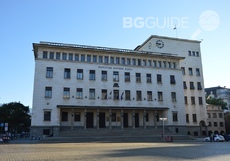
The Bulgarian National Bank was established in 1879.
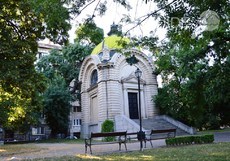
The grateful people of Bulgaria built the first Head of State of modern Bulgaria- Alexander of Battenberg a Memorial Tomb better known as the Battenberg Mausoleum.
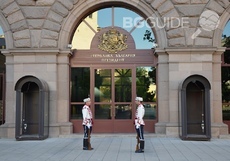
The Executive Office of the President of the Republic of Bulgaria is in the Presidency building at 2 Dondukov Blvd.

"Knyaz Alexander I" Square is a prominent landmark regularly used for various major events – large-scale live events.
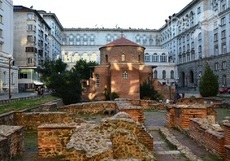
Тhe "St. George" Rotunda Church is situated in the courtyard of the Presidential Office Building, amid remains of the ancient town of Serdica.
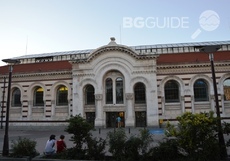
The Central Market Hall is among Sofia's most emblematic buildings.
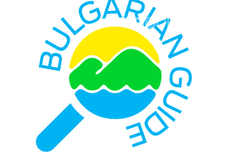
The splendid Renaissance Revival Style building of the Central Military Club has been among the jewels of downtown Sofia for over a hundred years.
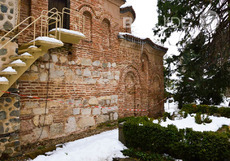
The medieval church of "St. Nicholas and St. Panteleimon” , better known as the Boyana Church, is located in the Boyana Borough in Sofia.

The city center of Sofia is in fact among the best sources of knowledge of the ancient and medieval way of life in these places.
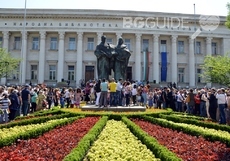
The largest library in Bulgaria “SS. Cyril and Methodius”, keeps more than 7.9 million items: books, rare editions, maps and graphics, archives, periodicals, manuscripts, electronic documents and databases, recordings etc.
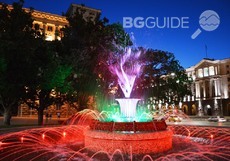
The fountain in front of the Presidential Office was designed and built in the 1950s.

A true paragon of the church architecture of the II Bulgarian kingdom - "St. St. Cyril and Methodius" rises in the very heart of Sofia.